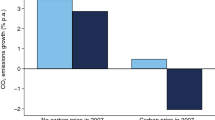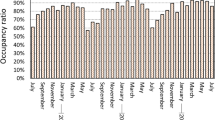Abstract
Allocation of emissions allowances may have significant distributional and efficiency effects. It is well known that cost-efficiency may be achieved if allowances are auctioned or distributed in a lump sum manner, e.g., based on emissions levels before the start of the system (‘grandfathering’). Böhringer and Lange (Eur Econ Rev 49:2041–2055, 2005) show that a cost-effective outcome can also be achieved if the base year for allocation is continually updated (‘updating’), given that banking and borrowing are prohibited. In this paper we examine whether updating alters the entry and exit conditions for firms compared to grandfathering, and how it affects profits for new and existing firms. We find that the two schemes function surprisingly similar: First, the incentives to entry and exit are identical. Second, the total value of free quotas to existing firms, based on emissions before the system starts, is also identical without any auctioning. With updating initial claims for free allowances have a shorter lifetime compared to grandfathering, but quota prices are higher as firms anticipate the effect of current emissions on future claims to free allowances. The two effects exactly cancel each other out. If there is some combination of auction and free allocation, the total value of free quotas will always be highest under grandfathering if the auction rate is the same. Entry and exit incentives are still equal.
Similar content being viewed by others
References
Åhman M, Burtraw D, Kruger J, Zetterberg L (2007) A ten-year rule to guide the allocation of EU emission allowances. Energy Policy 35: 1718–1730
Armstrong C (2008) Using history dependence to design a dynamic tradeable quota system under market imperfections. Environ Resour Econ 39(4): 447–457
Bovenberg AL (1999) Green tax reforms and the double dividend: an updated reader’s guide. Int Tax Public Financ 6: 421–443
Böhringer C, Lange A (2005) On the design of optimal grandfathering schemes for emission allowances. Eur Econ Rev 49: 2041–2055
Burtraw D, Evans DA, Krupnick A, Palmer K, Toth R (2005) Economics of pollution trading for SO2 and NO x . Ann Rev Environ Resour 30: 253–289
Burtraw D, Palmer K, Kahn D (2005b) Allocation of CO2 emissions allowances in the regional greenhouse gas cap-and-trade program. Discussion paper 05-25. Resources for the future
Burtraw D, Kahn D, Palmer K (2006) CO2 allowance allocation in the regional greenhouse gas initiative and the effect on electricity investors. Electr J 19(2): 79–90
Considinea TJ, Larson DF (2006) The environment as a factor of production. J Envir Econ Manag 52: 645–662
Convery FJ, Redmond L (2007) Market and price developments in the European union emissions trading scheme. Rev Environ Econ Policy 1(1): 88–111
Ellerman AD (2008) New entrant and closure provisions: how do they distort? Energy J Spec Issue Acknowledge Contrib Campbell Watkins Energy Econ: 63–75
Eshel DMD (2005) Optimal allocation of tradable pollution rights and market structures. J Regul Econ 28(2): 205–223
EU (2003) Directive 2003/87/EC of the European parliament and of the council of 13. October establishing a scheme for greenhouse gas emission allowance trading within the community and amending Council Directive 96/61/EC, European Commission, Brussels
EU (2005) Further guidance on allocation plans for the 2008 to 2012 trading period of the EU Emission Trading Scheme, European Commission, Brussels
Fischer C, Parry IWH, Pizer WA (2003) Instrument choice for environmental protection when technological innovation is endogenous. J Environ Econ Manag 45(3): 523–545
Fischer C, Fox AK (2007) Output-based allocation of emissions permits for mitigating tax and trade interactions. Land Econ 83: 575–599
Hatcher A, Read A (2001) The allocation of fishing rights in UK fisheries. In: Shotton R (ed) Case studies on the effects of transferable fishing rights on fleet capacity and concentration of quota ownership. FAO fisheries technical paper 412, FAO, Rome
Helm C (2003) International emissions trading with endogenous allowance choices. J Public Econ 87: 2737–2747
House of Representatives (2009) The American Clean Energy and Security Act (H.R. 2454), Bill text as passed by house of representatives. http://energycommerce.house.gov/Press_111/20090701/hr2454_house.pdf
Jensen J, Rasmussen TN (2000) Allocation of CO2 emission permits: a general equilibrium analysis of policy instruments. J Environ Econ Manag 40: 111–136
Keats Martinez K, Neuhoff K (2005) Allocation of carbon emission certificates in the power sector: how generators profit from grandfathered rights. Clim Policy 5: 61–78
Kling C, Rubin J (1997) Bankable permits for the control of environmental pollution. J Public Econ 64: 101–115
Mackenzie IA, Hanley N, Kornienko T (2008) The optimal initial allocation of pollution permits: a relative performance approach. Environ Resour Econ 39: 265–282
Mæstad O (2007) Allocation of emission permits with leakage through capital markets. Resour Energy Econ 29: 40–57
Montgomery WD (1972) Markets in licenses and efficient pollution control programs. J Econ Theory 5: 395–418
Neuhoff K, Åhman M, Betz R et al (2006) Implications of announced phase II national allocation plans for the EU ETS. Clim Policy 6: 411–422
Paltsev S, Reilly JM, Jacoby HD et al (2007) Assessment of US cap-and-trade proposals. MIT Report No. 146, April 2007
Rosendahl KE (2008) Incentives and prices in an emissions trading scheme with updating. J Environ Econ Manag 56: 69–82
Rosendahl KE, Storrøsten HB (2008) Emissions trading with updated grandfathering: entry/exit considerations and distributional effects. Discussion paper No. 546. Statistics Norway. http://www.ssb.no/publikasjoner/etter_serie/dp/
Schwarze R, Zapfel P (2000) Sulfur allowance trading and the regional clean air incentives market: a comparative design analysis of two major cap-and-trade permit programs?. Environ Resour Econ 17(3): 279–298
Spulber DF (1985) Effluent regulation and long-run optimality. J Environ Econ Manag 12: 103–116
Author information
Authors and Affiliations
Corresponding author
Rights and permissions
About this article
Cite this article
Rosendahl, K.E., Storrøsten, H.B. Emissions Trading with Updated Allocation: Effects on Entry/Exit and Distribution. Environ Resource Econ 49, 243–261 (2011). https://doi.org/10.1007/s10640-010-9432-z
Accepted:
Published:
Issue Date:
DOI: https://doi.org/10.1007/s10640-010-9432-z




